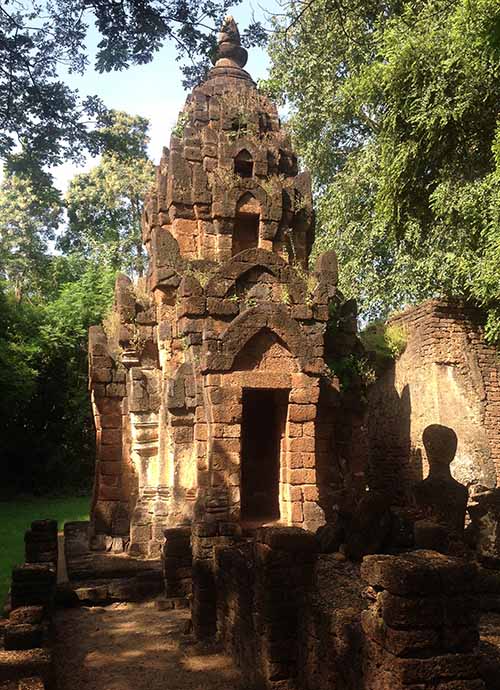
Wat Chao Chan
The Wat Chao Chan is a 13th century Buddhist temple located in Chaliang, a few kilometers East of the ancient walled town of Si Satchanalai. The temple is found near the banks of the Yom river, close to two other ancient monuments, the Wat Chom Chuen and the Wat Phra Si Rattana Mahathat Chaliang.
Early 13th century Khmer temple
The Wat Chao Chan predates the Sukhothai Kingdom. It was founded in the early 13th during the Khmer era.
During the reign of King Jayavarman in the late 12th, early 13th century the Khmer established Chaliang as a satellite town of their empire. Jayavarman VII was one of Angkor’s greatest Kings who built numerous temples, as well as hospitals and a system of roads with rest houses connecting various parts of the empire.
The Wat Chao Chan consists of a Khmer style central sanctuary, an ubosot and a mandapa. The temple was probably built on top of older structures. Fragments of brick and artifacts have been discovered from the earlier Dvaravati era, which started in the 6th century.
Khmer style prasat
The oldest structure of the Wat Chao Chan is the prasat, a Khmer style tower, probably constructed during the reign of Angkor King Jayavarman VII. The prasat has been restored. Built from blocks of laterite covered with a layer of plaster, the Bayon style prasat was constructed to enshrine a relic of the Buddha.
The central sanctuary has portals on all four sides. The East one contains the entrance facing the viharn. The other three sides contain false entrances, a feature often seen in Khmer architecture. The niches that are now empty enshrined images of the Buddha. The pediments over the entrances are undecorated.
The prasats upper part consists of a number of receding tiers shaped like the petals of lotus flowers topped with an amalaka, a stone disc, and a small tapering spire. Inside the tower are several alters on which present day devotees have placed various Buddha images and incense sticks.
Mandapa and viharn
Two other structures on the grounds, the mandapa and the viharn are later additions, built during the Sukhothai era. In front of the prasat stands the viharn, built of laterite blocks. Little more than the base and lower part of the columns that supported the roof remain. Seated on a raised platform to the back of the building are several badly eroded laterite Buddha images. During excavations ceramic tiles were found decorated with Bayon style designs.
Behind the prasat stands a mandapa similar to the one of the nearby Wat Phra Si Rattana Mahathat Chaliang. The structure enshrined a large Sukhothai style Buddha named Phra Attharot. The laterite image has largely weathered away; merely its outlines remain today. Phra Attharot images were popular during the Sukhothai era; similar ones can be found at the Wat Mahathat and Wat Saphan Hin in Sukhothai Historical Park.
- Wat Chang Lom
- Wat Phra Si Rattana Mahathat
- Wat Chedi Chet Thaeo
- Wat Nang Phaya
- Wat Khao Phanom Phloeng
- Wat Chom Chuen